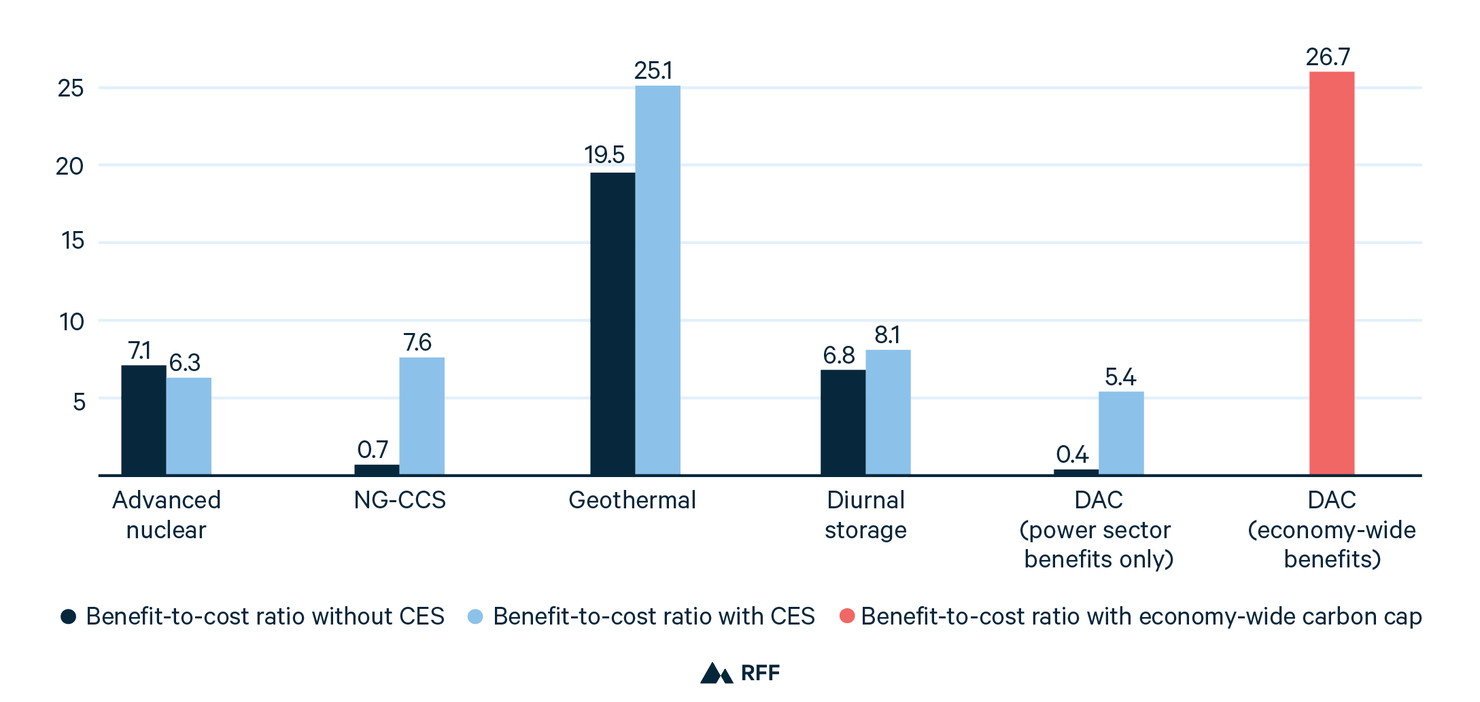The Value of Advanced Energy Funding: Projected Effects of Proposed US Funding for Advanced Energy Technologies
A rigorous survey of technology experts with detailed simulation modeling estimates some of the benefits of increased research, development, and demonstration funding for several advanced energy technologies.
Key Takeaways
- Conservatively, average power sector benefits across the technologies are likely to outweigh costs by 10.5 times with a national clean electricity standard, and 6.9 times without such standard.
- Ten years of additional funding, like what is authorized by the Energy Act of 2020, would generate average societal benefits of almost $40 billion per technology from 2040–2060.
- The experts expect the additional funding to reduce the costs of the technologies by 9–30 percent in 2035 compared to without it.
- Consumer electricity savings amount to an average of approximately $56 per household per year for each technology with a clean electricity standard, and $14 per household per year for each technology without one.
Executive Summary
This study estimates some effects of proposed additional US government funding for research, development, and demonstration (RD&D) of five advanced clean energy technologies: advanced nuclear, generation from natural gas with carbon capture and sequestration (NG-CCS), advanced geothermal, diurnal energy storage, and direct-from-air capture of CO2 (DAC). Specifically, we estimate the effects of the additional funding on the costs of these technologies and some of the societal benefits that would result from these cost reductions.
The Energy Act of 2020, which became US law in December 2020, authorizes additional funding for those five advanced energy technologies (AETs). Although work on this study began before the law passed, the funding levels we evaluate in the study were based on a remarkably close prediction of the final bill’s programs and authorized funding amounts for the AETs. It is uncertain how much funding each of the technologies will receive—they could receive less than authorized in the act, or more, perhaps as part of stimulus, infrastructure, or energy legislation.
In a rigorous expert elicitation process, we asked 26 experts in these five technologies to estimate the effect of additional funding on the levelized costs of new facilities using these technologies, in 2035. We asked the experts to assume that the added funding would be provided for 10 years, from 2022 to 2031. Their answers indicate that additional funding would result in average cost reductions of approximately 29 percent for advanced geothermal, 29 percent for DAC, 25 percent for nuclear, 16 percent for diurnal storage, and 9 percent for NG-CCS in 2035. These percentages reflect estimates of how much lower the cost of each technology would be with the added RD&D funding than without it.
Figure ES1. Estimated Benefit-to-Cost Ratios from 10 Years of Higher RD&D Funding

To estimate some of the benefits of these cost reductions for society, we used detailed power sector simulations of the year 2050 with and without a national clean electricity standard (CES) that requires 94 percent clean power by 2050. We make the conservative assumption that the experts’ cost projections for 2035 would still apply in 2050, even though costs tend to decline over time, deployment accelerates the cost reductions, and lower costs significantly increase the benefit from further cost reductions. Our simulations indicate that without a national CES, the benefits from the additional funding would be a mix of electricity bill savings, reduced health damages, and reduced climate damages. With a national CES, on the other hand, the benefits would come mainly from electricity bill savings. These electricity user savings amount to an average of approximately $14 per household per year for each technology without a CES and $56 per household per year for each technology with a CES.
Figure ES1 shows the estimated benefit-to-cost ratios of additional funding for each technology. The costs are the added US public and private RD&D spending, based on the experts’ responses. We assume the benefits estimated by the simulation last 20 years (mid-2040 to mid-2060). The ratios are present value of benefits over present value of costs, using a 3 percent real discount rate. Overall, we estimate that the additional funding would produce an average benefit-to-cost ratio for each technology of 6.9 without the CES and 10.5 with it. Without the CES, three of the five technologies have benefit-cost ratios above 1 (in fact, above 6). With the CES, all five technologies have benefit-cost ratios above 4. These benefit-to-cost ratios do not count benefits outside the years 2040 to 2060, US RD&D expenditure changes outside the 10-year period from 2022 to 2031, US export revenues, US benefits from reduced foreign emissions, or net benefits abroad.
Further, these benefit-to-cost ratios count only the benefits inside the electricity sector, whereas in reality, benefits in other sectors, such as industry, transportation, and consumer products, are likely for all five of the technologies.
A DAC study by Hafstead (2020) allows us to also estimate the US economy-wide benefit-to-cost ratio for the added DAC RD&D funding in the presence of a policy that cost-effectively reduces economy-wide emissions to approximately 50 percent below 2005 levels by 2050. In this situation, we estimate that benefits of additional DAC funding would be 27 times as great as the costs, as shown in the right-most portion of Figure ES1.
Our results also indicate that the benefits of each $1 reduction in expected levelized cost per MWh grow substantially larger as expected cost falls. This implies that the expected benefits per dollar of additional RD&D funding for each technology could actually grow larger per dollar spent on that technology.
To read the full paper, click "Download" above. The associated issue brief is linked below.
Related
Appendix
Summaries of Relevant Content from American Energy Innovation Act
Below are summaries of the parts of the American Energy Innovation Act (AEIA) that are relevant to each advanced energy technology. The AEIA was the legislative proposal experts were asked about, and it was the basis of the relevant part of the Energy Act of 2020.
- AEIA Summary - Advanced Nuclear.pdf
- AEIA Summary - CCS.pdf
- AEIA Summary - DAC.pdf
- AEIA Summary - Diurnal Energy Storage.pdf
- AEIA Summary - Geothermal.pdf
- AEIA Summary - Multiday Energy Storage.pdf
Expert Elicitation Survey Questions
The questions each expert was asked are included below in Excel format.
- Expert Elicitation Questions - Advanced Nuclear.xlsx
- Expert Elicitation Questions - CCS.xlsx
- Expert Elicitation Questions - DAC.xlsx
- Expert Elicitation Questions - Diurnal Storage.xlsx
- Expert Elicitation Questions - Geothermal.xlsx
- Expert Elicitation Questions - Multiday Storage.xlsx
Expert Elicitation Survey Instructions
The instructions provided to each expert for the expert elicitation survey are provided below.







